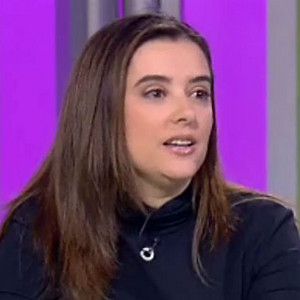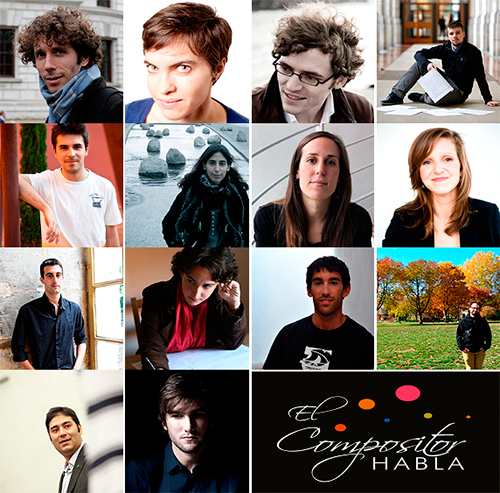Entrevistas
«unpredictable, unclosable, unrepeatable...» Johannes S. Sistermanns
18/12/2023
Una entrevista de Ruth Prieto para El Compositor Habla
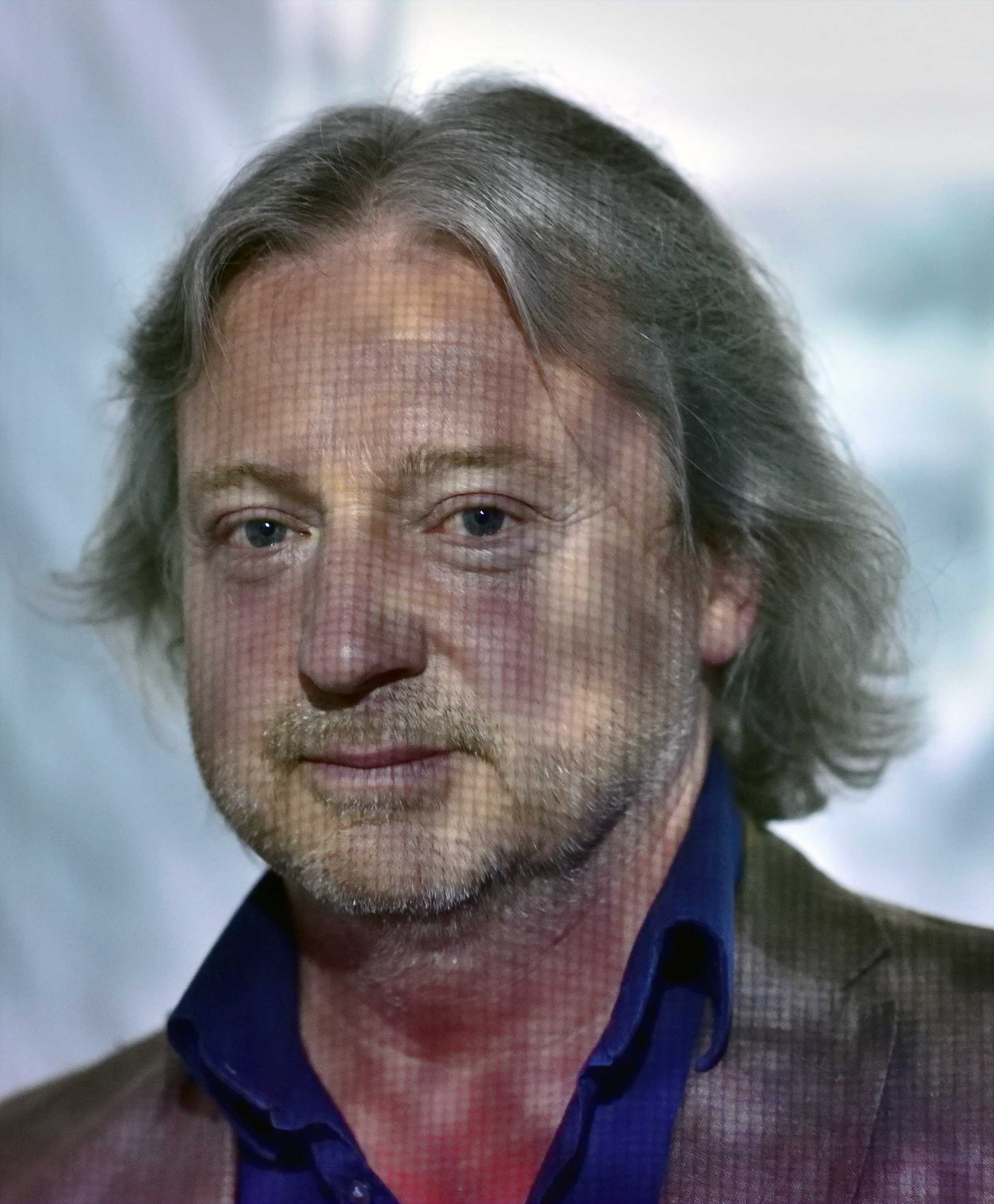
He has just published his latest work in World edition, which includes 36 electroacoustic miniatures, a very interesting and tremendously original work based on his extensive sound archive. We have spoken with Johannes S. Sistermanns and this is what he told us
1. Ruth Prieto: World Edition has just published your latest work UN ENT LOS, what will we find on this CD?
Johannes S. Sistermanns: In the best case, it's a confrontation with oneself. The sounds are not set to music, or any text or thoughts. It's about perception, not representation. The listener won't find composed transitions. The sound abruptly breaks off; it becomes harsh at times, soft at others, and at one point a text by Linda Marie Walker is heard. One second is inserted between the 36 short pieces. This silent space between is a rupture in sound-time. Highly diverse atmospheres, sonic spaces, moods, and 36 sonic particles collide unexpectedly. This creates interstices. They are consciously chosen by me to decouple the listener, to detach them from their expectation and imagination. The listener is exposed to a listening experience that is sudden, unpredictable, and unfinishable, nothing of the usual familiarity within them.
«On this CD, you won't find a finished product. The listener is invited to enter their space of perception and surrender to their own, personal resonance»
2. R.P.: What does this play on words UN ENT LOS mean and how does it resonate with the endless or the infinite.
Johannes S. Sistermanns: UN/ENT refers to any word in the German language that begins with the prefixes 'un,' 'ent,' and ends with the suffix 'los.' In English, it corresponds to 'un-', 'de-' and '-less'. Three UN words that are electrifying for me are: unpredictable, unending unrepeatable. ENT is the German prefix for decoupling, and LOS, in German, means to detach, leaving it to the moment... boundless... limitless... It can be an invitation to approach one's own unknowing. We seem to have a sense that our unknowing is greater than our knowledge... something that perhaps never ends and is limitless.
«We seem to have a sense that our unknowing is greater than our knowledge... something that perhaps never ends and is limitless»
3. R.P.: If there is music that is exceptionally complex to classify in the panorama of contemporary creation, it is probably yours due to its originality. How would you define your music?
Johannes S. Sistermanns: I haven't done anything to define my music yet. Why, to understand it? The mind always wants to hold on, to secure. I have great confidence in my unknowing. Only organizing creates a here and there, up to the wall and beyond. Concepts, genres, theories, forms and habits are walls. They draw boundaries. They organize a totality that always already exists. If this does not apply to an artist, he becomes a border crosser for others. But I cannot allow myself to be defined by the boundaries and codes of others and then explain to them how I can overcome their boundaries. I don't have their boundaries. This kind of arbitrary demarcation does not live in me. And according to my observations, we humans don't live like that either. Isn't this kind of behavior, labeling myself as a border crosser, also an expression of self-appointed guardians of conventions, concepts, beliefs and dogmas?
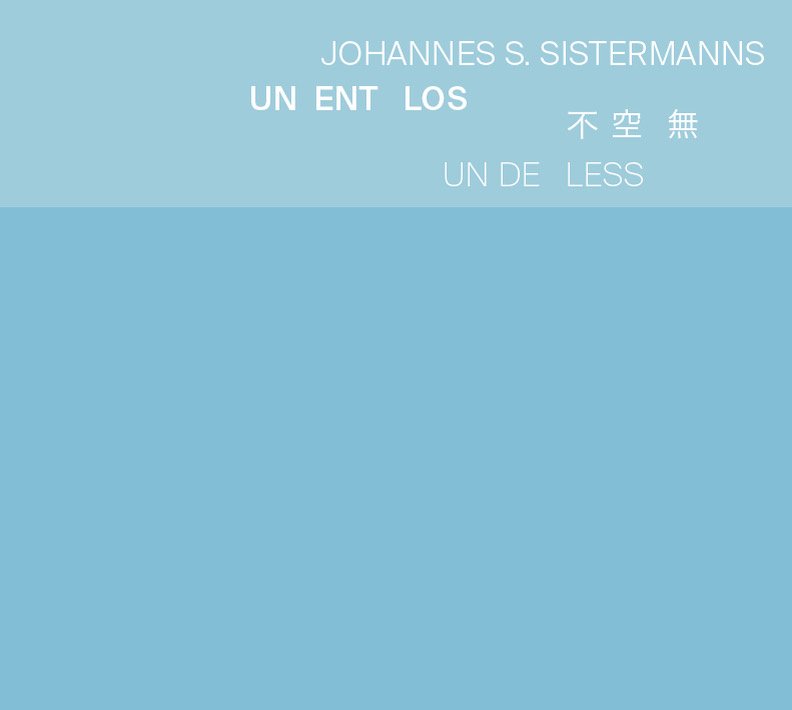
4. R.P.: The CD includes 36 electroacoustic miniatures, for which you have based your extensive sound archive. Why have you chosen this starting point?
Johannes S. Sistermanns: If I had started composing under the heading UN ENT LOS, I would have had to develop a precise understanding of it initially. That would have been equivalent to making a clear statement or definition of UN ENT LOS. With every self-chosen theme, I delve maximally into its confirmation but never beyond. One wants to comprehensively capture and express everything, yet one does not realize that with this approach, one closes off more than one opens. I allowed myself to be newly captured by sounds, devoid of memory, from my archive. The sounds that activated, touched, seduced, or tore me open have come together here. No sound was composed directly for this CD in its original moment. That is my guarantee for the greatest possible decoupling of all 36 soundtracks from each other. Not composing UN ENT LOS. Provoking unfinishability, decoupling, and detachment in sound. Perceiving free associations. Liberating oneself from the idea as an impulse already gone through a thought process of conception.
«Liberating oneself from the idea as an impulse already gone through a thought process of conception»
All of this describes the initial steps toward the composition of the 36 soundtracks, the seconds-long pauses, and the endlessness of beginnings and endings.
5. R.P.: The material of your composed and fleeting sound moments are the sounds of the numerous musical instruments you play and their electroacoustic transformation. How has electroacoustics influenced your creation process?
Johannes S. Sistermanns: Electroacoustics, sound processing, have been able to carry sounds far away from their, my place of origin. I prefer to use all audio technology for this, to calculate or delete frequencies from existing instrumental sounds, found noises, as well as recorded atmospheres from places, voices, and natural landscapes. However, consistently moving far away from the original material leads me into the realm of what only sound can achieve. Where I end up through this sensory-compositional process is somewhere I have never been before.
6. R.P.: The soundscape and what you call "spatial sounds" are also very present in your work, is it an important part of your creative process?
Johannes S. Sistermanns: All of this holds equal importance in my perceptual world. Self-recorded ambient sounds in nature, in 20-million-population cities like Osaka, Mumbai, Beijing, Tokyo, Shanghai, or New York, are as present as sounds from private living spaces, waterworks, electric cars, or the hollow spaces under bridges. For me, 'space' is another parameter in music. Specifically, interior spaces are instruments for me, just like a cello, a concert grand piano, or even an entire orchestra in the composition 'Unstrument.' In this composition, there is not a single orchestral musician on stage, but the instruments play
Unstrument from Johannes S. Sistermanns on Vimeo.
By transmitting tone, sound, or noise frequencies through body-sound membranes to solid bodies such as wood, plastic, glass, aluminum, paper, or instruments, I set a space into vibration through its constitutive materials. I seek the authenticity of this space: When is a space itself? I perceive all of this as a sonic landscape of acoustic indeterminacy, frequent expansiveness, never-closed mixing ratios, always different, and, above all, there is a sense of incompleteness and unrepeatability in the vibrations. These audio recordings from globally realized installative ‚Sound Sculptures‘ [KlangPlastik http://www.sistermanns.eu/#category/soundplastics] are as much a part of my compositions on this CD as what I term 'space tones': With my voice, I capture the architectural space acoustically in its inherent vibration. Physicists speak of a 'standing wave.' To give an analogy, it is the 'acoustic photography of an architectural space.' I experience space tones as boundless, without a center and direction. Space tones ground me in a sensory listening experience. Simultaneously, they transport me into other spaces. All of this makes me feel the incompleteness and unrepeatability in the realm of endless possibilities within space.
7. R.P.: Why do you pursue this decoupling as a composer in your own work?
Johannes S. Sistermanns: Decoupling creates space. A free space that cannot be defined at first. I pursue decoupling with the vision of an inexhaustibly vibrating potential space. With a statement, how or what something is, it seems like everything is already concluded. With a term, it seems like everything is already formulated. And then, I repeatedly experience that it is not as stipulated by others. That was my initial moment many years ago, consciously choosing to decouple: It was part of my daily life and then also my artistic practice that my origin was shaped by a sense of security. However, at some point, I recognized the potential for stagnation in security. So, I did not want to continue like that; I just knew it had to be different. I opted for uncertainty, for approaching what was unknown and unfamiliar to me. I detached myself from dogmas, beliefs, and formats. I decoupled from what was familiar and known until then. Notions, ideas, concepts - which have always passed through a thought and are therefore limited - dissolved from me. I made the discovery: decoupling creates space. Between me and what is left behind. I recognized the incompleteness of my current perception. From this rupture emerged a breakthrough. Recognize the opened space as an intermediate zone. Allow what emerges within it to grow and also let it be.
Since then, momentary impulses and intuition determine me, unquestioningly and without expectations, rising within me. What rises is valid, and I follow it.
Music before Thinking
/ Music before thinking
/ Doing before knowing
/ is /
/ long before form and concept /–/
/ what rises now is valid
© Johannes S. Sistermanns
CONCISE
Positions on Contemporary Music
edited by Stefan Fricke
Saarbrücken, PFAU-VERLAG, 2006, p. 5
"Impulse" seems to be an appropriate word for it now. I surrender myself to intuitive impulses until they become the sound, color of a room, atmosphere."
I operate from a potential space. I am then within myself, finding myself in a state of continuous emergence. Inspiration lives briefly, cannot be captured, knows neither order nor reason. This is a groundbreaking statement of inspiration itself. Where does one find oneself then? Does not every listener also become an instrument when these sounds play them? Does the listener not primarily listen to themselves in their resonant being? In the intensification of this, the listener detaches themselves from my music, thus being activated to experience something new = unknown in their own in-between space?
"Sistermanns operates from a space of potential. It is no longer the limits of the material nature of instruments (eg cello, piano) or spaces that are constitutive for this potential space but the informational power of individual perceptual capacity." Vera Bühlmann, Media philosopher [unpublished manuscript, Vienna 2008]
8. R.P.: What would you like to offer the listener as an expectation of listening?
Johannes S. Sistermanns: Expectancy-lessness. The detachment, decoupling from your expectation. So detached from your expectation, let yourself be played by the sound. The sound is always only now. Listening is now. Enter your perceptual space. In your resonance, the composition takes place. Music, sounds, atmospheres, space tones are not a finished product, not an object. They are decoded only by us. The perceiver entering into these free spaces, interstices, qualifies every space, every sound. This is an event.
Johannes S. Sistermanns, studied composition and new music theatre with Mauricio Kagel at the Cologne Musikhochschule, took singing lessons in North India and earned a doctorate in musicology. He realises his projects in installation sound sculpture, radiophonic radio play, electroacoustics and sound performance. In his installations, he penetrates resonant everyday materials, overcomes architectural spaces with sounds and acts impulsively from an unknown potential space. Worldwide, Johannes S. Sistermanns receives composition commissions, grants, residencies, guest lectureships and numerous prizes, including the Karl Sczuka Grant Prize for Radio Art of the SWR in 1997, the GERMAN SOUNDART PRIZE 2008 of the Radio WDR Cologne and Sculpture Museum Marl, the 12th GERMAN MUSIC AUTHOR’S' PRIZE 2020 (GEMA Berlin) and the GRAND PRIX NOVA - SILVER AWARD 2022 Radio Romania Bucharest.
He realises multi-media sound art exhibitions at international festivals such as at the Adelaide/Melbourne Festival, EXPO 2000 World Exhibition Hanover, Musicarama Hong Kong, Donaueschinger Musiktage, International World Music Days Switzerland/Sydney/Stuttgart, NYCEAMF New York Electroacoustic Music Festival, Meion Festival Nagoya, Japan.
Las fotos de Johannes S. Sistermanns son de © Mongi Taleb (la primera)
La segunda es la cartula del CD
2023 © Johannes S. Sistermanns. Bornheim/Cologne 15. December 2023
Más información sobre el compositor en su página web Johannes S. Sistermanns
Más información sobre el CD en la página web World-Edition
Biblioteca
Destacamos ...
Nueva Sección Directorio
dedicada a la promoción de compositores, intérpretes, instituciones y editoriales.
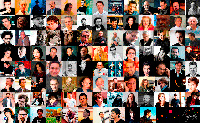
dedicada a la promoción de compositores, intérpretes, instituciones y editoriales.


